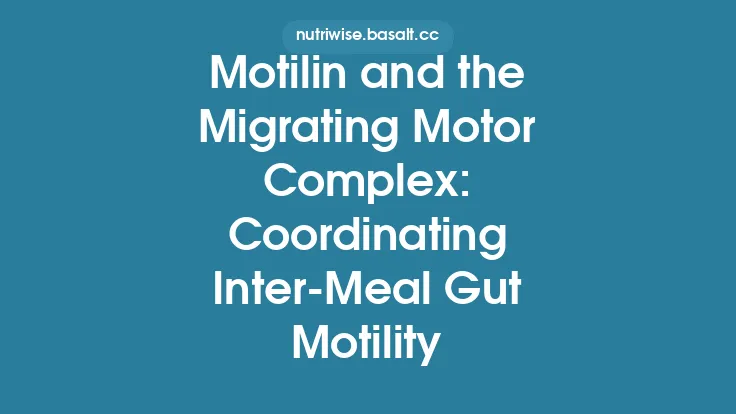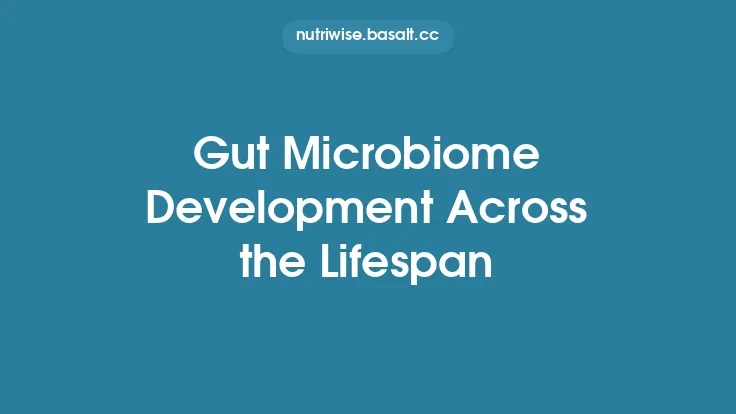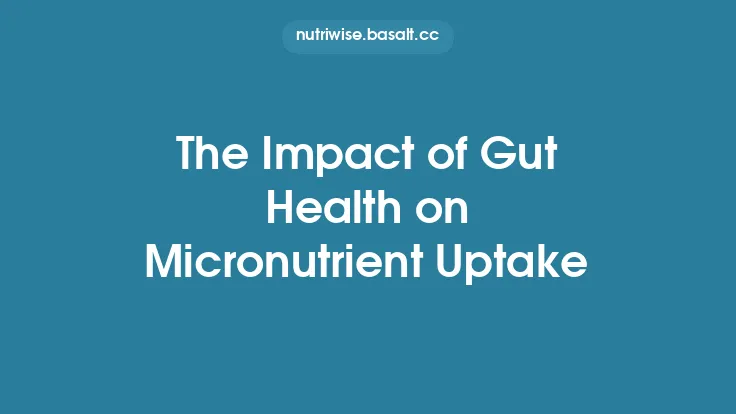The gut microbiome is a dynamic ecosystem that can be tipped out of balance by a wide array of internal and external pressures. While a healthy microbiota is resilient, repeated or severe disturbances can lead to a state of dysbiosis—characterized by reduced diversity, loss of beneficial taxa, and over‑representation of opportunistic organisms. Dysbiosis has been linked to metabolic, inflammatory, and neuro‑behavioral disorders, making it essential to understand both the forces that destabilize the microbial community and the pathways through which balance can be re‑established.
Common Disruptors of the Gut Microbiome
Disruption does not arise from a single cause; rather, it is the cumulative effect of multiple stressors that act on microbial populations, their metabolic networks, and the host environment. The most frequently reported categories include:
| Disruptor | Primary Mechanism | Typical Duration of Impact |
|---|---|---|
| Broad‑spectrum antibiotics | Direct killing of susceptible bacteria; selection for resistant strains | Weeks to months, sometimes years |
| Non‑antibiotic pharmaceuticals (e.g., PPIs, antipsychotics) | Altered gastric pH, antimicrobial side‑effects, modulation of host signaling pathways | Variable, often chronic |
| Acute or chronic psychological stress | HPA‑axis activation → cortisol release → altered gut motility and mucus production | Days to months |
| Environmental toxins (heavy metals, pesticides) | Direct microbial toxicity; interference with microbial enzymatic pathways | Persistent, depending on exposure |
| Lifestyle irregularities (sleep deprivation, shift work) | Disruption of circadian rhythms that synchronize microbial gene expression | Ongoing with the behavior |
| Pathogenic infections | Overgrowth of invasive species; immune‑mediated collateral damage | Acute phase, with possible long‑term sequelae |
| Hormonal fluctuations (menopause, thyroid disorders) | Shifts in bile acid composition and mucosal immunity | Chronic, hormone‑dependent |
Understanding the specific pathways through which each factor exerts its influence is crucial for designing targeted restoration strategies.
Antibiotics and Other Pharmaceuticals
Antibiotics
Broad‑spectrum agents such as fluoroquinolones, macrolides, and β‑lactams indiscriminately eradicate susceptible commensals while sparing resistant strains. This creates ecological niches that can be filled by opportunistic pathogens (e.g., *Clostridioides difficile*). The loss of keystone species—organisms that shape community structure through metabolic cross‑feeding—can persist long after the drug is cleared, leading to reduced short‑chain‑fatty‑acid (SCFA) production and impaired colonization resistance.
Non‑Antibiotic Medications
- Proton Pump Inhibitors (PPIs): By raising gastric pH, PPIs allow oral bacteria to survive transit, altering the downstream composition of the small‑intestine microbiota. Studies have shown increased relative abundance of *Streptococcus and Enterococcus* species in chronic PPI users.
- Antipsychotics and Antidepressants: Many of these drugs possess intrinsic antimicrobial activity. For instance, the atypical antipsychotic olanzapine has been shown in murine models to reduce *Bacteroidetes and increase Firmicutes*, a shift associated with weight gain.
- Metformin: While primarily an antidiabetic agent, metformin modulates the gut microbiome by increasing *Akkermansia muciniphila and SCFA‑producing Bifidobacterium* spp., illustrating that some pharmaceuticals can have beneficial microbiome effects.
The pharmacokinetic and pharmacodynamic properties of each drug determine the depth and duration of microbial perturbation. Clinicians increasingly consider these off‑target effects when prescribing long‑term therapies.
Stress and the Brain‑Gut Axis
Psychological stress activates the hypothalamic‑pituitary‑adrenal (HPA) axis, leading to systemic cortisol elevation. Cortisol influences gut physiology in several ways:
- Motility Changes: Stress can accelerate or decelerate transit time, altering the residence time of microbes and their substrates.
- Mucus Layer Integrity: Cortisol reduces mucin gene expression, thinning the protective mucus barrier and exposing epithelial cells to bacterial antigens.
- Immune Modulation: Stress‑induced cytokine shifts (e.g., increased IL‑6, TNF‑α) can create a pro‑inflammatory milieu that favors the growth of pathobionts.
Animal studies demonstrate that chronic restraint stress reduces microbial diversity and specifically depletes *Lactobacillus* spp., a genus known for its anti‑inflammatory metabolites. Human longitudinal data echo these findings, linking high perceived stress scores with lower microbial richness.
Environmental Exposures and Toxins
Heavy Metals
Arsenic, lead, and cadmium accumulate in the gastrointestinal tract and exert selective pressure on microbial populations. For example, cadmium exposure in rodents leads to a marked increase in *Enterobacteriaceae and a concomitant decline in Bacteroides* spp. These shifts are mediated by metal‑induced oxidative stress, which damages bacterial DNA and proteins.
Pesticides and Food Additives
Organophosphate pesticides have been shown to inhibit bacterial enzymes involved in carbohydrate metabolism, reducing SCFA output. Similarly, artificial sweeteners such as saccharin can promote the expansion of *Bacteroides thetaiotaomicron*, which metabolizes these compounds into metabolites that may affect glucose tolerance.
Airborne Particulates
Inhaled particulate matter (PM2.5) can be swallowed and reach the gut, where it triggers low‑grade inflammation and alters bile acid composition—both of which influence microbial community structure.
Collectively, these environmental factors act as chronic stressors on the microbiome, often compounding the effects of diet and medication.
Lifestyle Factors: Sleep, Exercise, and Circadian Rhythm
Sleep Deprivation
Sleep loss disrupts the diurnal oscillations of microbial gene expression. In mouse models, 6‑hour sleep restriction for two weeks leads to a loss of rhythmicity in *Bacteroides and Lactobacillus populations, accompanied by reduced fecal butyrate concentrations. Human studies have correlated short sleep duration (<6 h) with increased Ruminococcus and decreased Faecalibacterium prausnitzii*, a key anti‑inflammatory bacterium.
Exercise
Physical activity exerts a bidirectional influence. Moderate aerobic exercise tends to increase microbial diversity and enriches SCFA‑producing taxa, whereas extreme endurance training can transiently increase *Proteobacteria*, a phylum often associated with inflammation. The mechanistic link appears to involve exercise‑induced changes in gut transit time, bile acid secretion, and systemic cytokine profiles.
Circadian Misalignment
Shift workers experience a misalignment between central (suprachiasmatic nucleus) and peripheral clocks, leading to altered feeding patterns and hormone release. This desynchronization disrupts the rhythmic expression of microbial enzymes involved in carbohydrate fermentation, resulting in a flattened diurnal pattern of SCFA production. Over time, such dysregulation can predispose individuals to metabolic disturbances.
Infections and Pathogen Overgrowth
Acute gastrointestinal infections—viral (e.g., norovirus), bacterial (e.g., *Salmonella), or parasitic (e.g., Giardia)—can cause a rapid collapse of microbial diversity. The inflammatory response, characterized by neutrophil influx and increased oxygen tension, favors facultative anaerobes such as Enterobacteriaceae*. Post‑infection, the microbiome may not fully revert to its pre‑illness state, especially if the host experiences repeated infections or receives antibiotics during treatment.
Chronic overgrowth of specific pathogens, such as *Candida albicans or Helicobacter pylori, can also drive dysbiosis. H. pylori infection, for instance, alters gastric acidity and reduces the abundance of acid‑sensitive commensals, while Candida* can produce metabolites that inhibit bacterial growth, further skewing community composition.
Age‑Related and Hormonal Influences
While the development of the microbiome across the lifespan is covered elsewhere, it is worth noting that age‑related hormonal changes can act as independent disruptors in adulthood. Menopause is associated with reduced estrogen levels, which in turn modify bile acid pools and mucosal immunity, often leading to a decline in *Bifidobacterium and an increase in Clostridium* clusters. Thyroid dysfunction, particularly hypothyroidism, slows gastrointestinal motility, creating an environment conducive to bacterial overgrowth in the small intestine.
Mechanisms of Microbial Resilience and Recovery
The gut microbiome possesses several intrinsic properties that confer resilience:
- Functional Redundancy: Multiple taxa can perform similar metabolic functions (e.g., SCFA production). When one group is depleted, others can compensate, preserving ecosystem function.
- Ecological Niches: Spatial heterogeneity along the gastrointestinal tract (mucosal vs. lumen, proximal vs. distal) provides refugia where sensitive microbes can survive during perturbation.
- Host‑Mediated Feedback: The host immune system and epithelial secretions (e.g., antimicrobial peptides) can selectively promote the regrowth of beneficial taxa after a disturbance.
- Horizontal Gene Transfer: Mobile genetic elements enable rapid acquisition of resistance or metabolic capabilities, allowing the community to adapt to new stressors.
Recovery trajectories depend on the magnitude of the disturbance, the presence of keystone species, and the host’s physiological state. Mild, transient disruptions often resolve within days to weeks, whereas severe or repeated insults may lead to a new, stable dysbiotic equilibrium.
Restorative Strategies: From Diet to Advanced Therapies
1. Targeted Dietary Modulation
While broad dietary patterns are covered in other articles, specific nutrient manipulations can be employed as therapeutic tools:
- Resistant Starch Enrichment: Resistant starches (e.g., high‑amylose maize) selectively feed *Ruminococcus bromii and Bifidobacterium* spp., boosting butyrate production.
- Polyphenol‑Rich Foods: Flavonoids from berries and green tea inhibit pathogenic *Enterobacteriaceae while promoting Akkermansia muciniphila*.
- Omega‑3 Fatty Acids: EPA/DHA can modulate bile acid composition, indirectly favoring bile‑tolerant commensals.
These interventions are often used in conjunction with other strategies to accelerate microbial recolonization.
2. Postbiotic Supplementation
Postbiotics are non‑viable microbial products (e.g., SCFAs, bacteriocins, cell wall fragments) that exert health benefits without requiring live organisms. Administration of purified butyrate or microbial‑derived indole derivatives can restore epithelial barrier function and dampen inflammation, providing a bridge while the native microbiota re‑establishes.
3. Phage‑Based Therapies
Bacteriophages can be harnessed to selectively reduce overabundant pathogenic strains without disturbing the broader community. Clinical trials are exploring phage cocktails targeting multidrug‑resistant *Enterococcus and Clostridioides difficile* as adjuncts to conventional treatment.
4. Fecal Microbiota Transplantation (FMT)
FMT involves transferring a screened, healthy donor stool suspension into the recipient’s colon, typically via colonoscopy, enema, or oral capsules. It is the most potent method for resetting a severely dysbiotic microbiome, with high success rates in recurrent *C. difficile* infection. Emerging protocols aim to standardize donor selection, microbial composition, and dosing to treat metabolic syndrome, ulcerative colitis, and even neuropsychiatric conditions.
5. Microbiome‑Targeted Small Molecules
Research is advancing small‑molecule modulators that influence microbial metabolism. For example, inhibitors of bacterial bile salt hydrolase can modulate the bile acid pool, indirectly shaping microbial composition. Similarly, compounds that block quorum‑sensing pathways can suppress virulence factor expression in pathobionts, allowing commensals to regain dominance.
6. Lifestyle Re‑Calibration
Re‑establishing regular sleep–wake cycles, incorporating moderate aerobic exercise, and reducing exposure to environmental pollutants (e.g., using water filters, avoiding high‑pesticide produce) create a host environment conducive to microbial recovery. Stress‑reduction techniques such as mindfulness meditation have been shown to lower cortisol levels, thereby improving mucosal barrier integrity and supporting microbial regrowth.
Personalized Approaches and Future Directions
The heterogeneity of dysbiosis—driven by individual genetics, baseline microbiome composition, and exposure history—necessitates personalized restoration plans. Emerging technologies are poised to refine these strategies:
- Metagenomic and Metatranscriptomic Profiling: High‑resolution sequencing can identify functional deficits (e.g., loss of butyrate‑producing pathways) rather than just taxonomic shifts, guiding targeted interventions.
- Machine‑Learning Predictive Models: Algorithms trained on large cohorts can predict an individual’s response to specific therapies (e.g., likelihood of FMT success) based on baseline microbial signatures.
- Synthetic Microbial Consortia: Designer communities composed of defined strains with complementary metabolic capabilities are being engineered to fill ecological niches left vacant after disruption.
- CRISPR‑Based Microbiome Editing: CRISPR‑Cas systems delivered via bacteriophages can selectively knock out deleterious genes in resident microbes, offering a precision tool for reshaping community function without wholesale transplantation.
As research progresses, the integration of these tools with clinical practice will enable clinicians to move beyond generic “restore balance” advice toward evidence‑based, individualized microbiome therapeutics.
In summary, the gut microbiome is vulnerable to a spectrum of disruptors ranging from pharmaceuticals and psychological stress to environmental toxins and lifestyle irregularities. Each factor perturbs microbial communities through distinct mechanisms—altering pH, oxygen levels, immune signaling, or nutrient availability. Recovery hinges on the ecosystem’s inherent resilience, but when dysbiosis becomes entrenched, targeted interventions—dietary refinements, postbiotic supplementation, phage therapy, fecal transplantation, and lifestyle optimization—are required to re‑establish a functional, diverse microbial community. Ongoing advances in omics technologies, computational modeling, and synthetic biology promise to make these restorative strategies increasingly precise, paving the way for personalized microbiome medicine that can maintain gut health throughout the lifespan.





